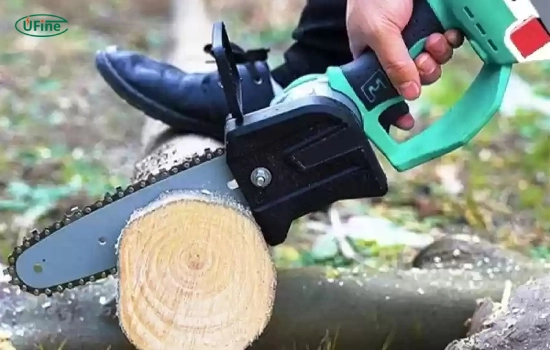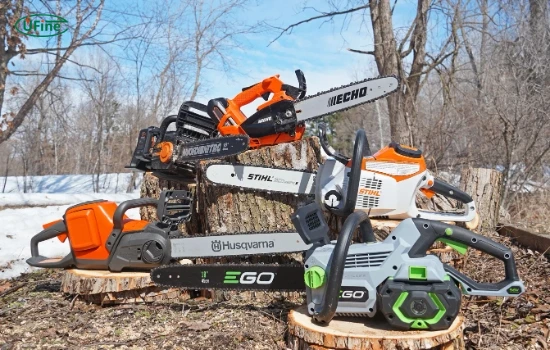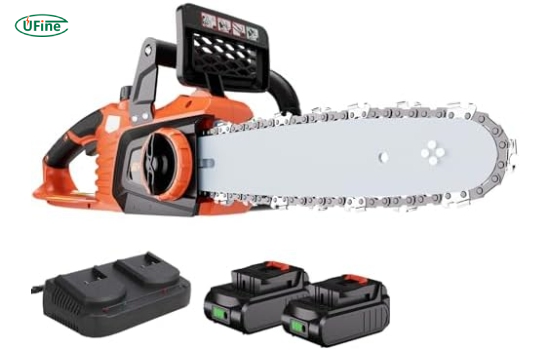
- Part 1. Understanding battery voltages
- Part 2. How does voltage affect the performance of a chainsaw battery?
- Part 3. Common chainsaw battery voltages
- Part 4. How to choose chainsaw battery voltage in 3 steps?
- Part 5. Factors to consider when choosing a chainsaw battery voltage
- Part 6. Chainsaw battery voltage FAQs
Quick Answer: The best chainsaw battery voltage depends on your needs:
- 🔋 12V-40V: Light pruning & small tasks
- 🔋 60V: Medium-duty cutting & frequent use
- 🔋 80V: Professional heavy-duty jobs
Keep reading for a detailed voltage comparison table and buying tips.
Chainsaw batteries have revolutionized how we approach outdoor power equipment, offering convenience, portability, and reduced noise compared to gas-powered models. However, with a wide range of voltages available, from 12V to 80V, it can be challenging to determine the optimal voltage for your needs. In this comprehensive article, we’ll explore the factors to consider when choosing the best voltage for your chainsaw battery, helping you make an informed decision that suits your specific requirements and enhancing your overall experience with battery-powered chainsaws.
Part 1. Understanding battery voltages
Battery voltage is a measure of the potential difference between a battery’s positive and negative terminals, and it determines the amount of power the battery can deliver. Higher voltages generally indicate more power and longer runtime. Still, they also come with a higher price tag and increased weight. When selecting the best battery for your chainsaw, understand the voltage, power, and runtime relationship.
Part 2. How does voltage affect the performance of a chainsaw battery?
Voltage plays a significant role in how well a chainsaw performs. Here’s how:
- Power Output: Higher voltage batteries provide more power, allowing for faster cutting speeds and the ability to tackle more rigid materials.
- Runtime: Batteries with higher voltages usually have larger capacities, so they can run longer before recharging.
- Motor Efficiency: Chainsaws with higher voltage batteries often have more efficient motors that can handle demanding tasks without overheating or stalling.
In summary, the voltage of your chainsaw battery directly influences its cutting capabilities, runtime, and overall efficiency.
Part 3. Common chainsaw battery voltages
Chainsaw Battery Voltage Comparison Chart
| Voltage | Best For | Runtime* | Weight | Price Range |
|---|---|---|---|---|
| 12V | Small branches (under 4″) | 20-30 mins | Ultra-light | $50-$100 |
| 40V | Medium logs (4″-8″) | 40-60 mins | Light | $100-$200 |
| 60V | Thick wood (8″-12″) | 60-90 mins | Moderate | $200-$300 |
| 80V | Professional felling | 90-120 mins | Heavy | $300+ |
*Runtime based on 4.0Ah battery capacity
The most common chainsaw battery voltages currently available range from 12V to 80V. Each voltage has advantages and disadvantages; the best choice depends on your requirements.
12V Chainsaws
12V chainsaws are suitable for light-duty tasks, such as pruning small branches or trimming hedges. These batteries offer a compact and lightweight solution, making them ideal for homeowners with limited storage space or those who need a portable tool for occasional use.
40V Chainsaws
40V chainsaws are a popular choice for homeowners and occasional users who need a reliable tool for light to medium-duty cutting tasks. These batteries offer a good balance of power, runtime, and weight, making them suitable for pruning, trimming, and cutting small to medium-sized logs. 40V batteries are generally more affordable and accessible for replacement batteries than higher voltages.
60V Chainsaws
Engineers design 60V chainsaws for more demanding cutting tasks, such as felling more giant trees or cutting through thicker logs. These batteries provide more power and longer runtimes than 40V models, making them suitable for professional use or for those who need to tackle challenging cutting jobs. However, 60V batteries are heavier and more expensive than their 40V counterparts.
80V Chainsaws
80V chainsaws represent the top-of-the-line in battery-powered chainsaw technology. These powerful tools are designed for heavy-duty cutting tasks, offering exceptional power and runtime. 80V batteries are ideal for professional arborists, landscapers, and those who need to tackle large-scale projects or work with thick, dense wood. However, the increased power and runtime come at the cost of higher weight and price.
Part 4. How to choose chainsaw battery voltage in 3 steps?
- Measure Your Cutting Needs
Branch Size: 12V for <4″, 40V for 4-8″, 60V/80V for >8″
Frequency: Occasional use (12V-40V) vs daily (60V-80V) - Calculate Required Runtime
20V/40V: 30-60 mins (small yards)
60V/80V: 1-2 hrs (large properties) - Check Compatibility
Stick to one battery ecosystem (e.g., DeWalt 20V MAX tools)
Verify chainsaw model supports the desired voltage
Part 5. Factors to consider when choosing a chainsaw battery voltage
When selecting the best voltage for your chainsaw battery, consider these factors:
Power Requirements
The power requirements of your chainsaw will significantly influence the voltage you need. Larger chainsaws with more oversized bars and demanding cutting tasks require higher voltages to maintain performance and efficiency. On the other hand, smaller chainsaws designed for lighter tasks may perform well with lower voltages, offering a more compact and lightweight solution.
Runtime
Battery runtime is another crucial factor to consider. Higher voltages generally provide longer runtimes, allowing you to work for extended periods without recharge. Suppose you frequently engage in lengthy cutting sessions or work on large projects. In that case, a higher voltage battery may be more suitable to minimize downtime and maximize productivity.
Weight and Portability
Battery weight is an important consideration, especially if you carry your chainsaw for long distances or work in challenging terrain. Higher-voltage batteries tend to be heavier, impacting your mobility and fatigue levels over time. If portability is a priority, opt for a lower-voltage battery with a more manageable weight while meeting your power requirements.
Cost
Battery cost is another factor to consider when choosing the best voltage. Higher-voltage batteries are typically more expensive, both in terms of the initial purchase price and the cost of replacement batteries. If budget is a concern, you may need to balance power, runtime, and cost to find the most suitable option for your needs and budget.
Answering Your Needs
To help decide on the correct voltage:
- A 12V or 40V battery should suffice if you do light trimming occasionally.
- For regular use with moderate cutting tasks, consider a 60V battery.
- For professional or heavy-duty work, an 80V battery is ideal.
You can decide which chainsaw battery voltage will work best by asking yourself these questions and considering your specific needs.
Part 6. Chainsaw battery voltage FAQs
What chainsaw battery voltage is best for cutting firewood?
A 60V chainsaw battery is ideal for cutting firewood. It efficiently handles 10-16″ logs with 60+ minutes of runtime. For smaller logs under 8″, a 40V battery may suffice for occasional use.
Can I use an 80V battery for light pruning?
Yes, but it’s overkill. 80V batteries are heavy (5-7 lbs) and expensive. For light pruning of branches under 4″, a 12V or 40V battery is more cost-effective and portable.
How long does a chainsaw battery last per charge?
Runtime varies by voltage and Ah rating:
- 12V (2.0Ah): 20-30 mins
- 40V (4.0Ah): 40-60 mins
- 80V (5.0Ah): 90-120 mins
Higher Ah batteries extend runtime but increase weight.
Are higher voltage chainsaw batteries safer?
Not necessarily. All modern chainsaw batteries have safety certifications. However, 80V batteries require extra caution due to higher energy density – always wear gloves and eye protection.
Do all battery voltages work with any chainsaw?
No. Chainsaws are designed for specific voltages. Using mismatched batteries can damage tools. Check your chainsaw’s manual – most brands, like DeWalt and Milwaukee, have exclusive battery ecosystems.
How to store chainsaw batteries in winter?
Store at 50-77°F with 30-50% charge. Avoid freezing temperatures, which permanently reduce lithium-ion battery capacity. If stored in unheated spaces, use insulated cases.
Related Tags:
More Articles

What is the Difference Between Silver Zinc Battery vs. Lithium-ion Rechargeable?
Compare silver zinc and lithium-ion rechargeable batteries: energy density, cycle life, safety, cost, and uses in drones, medical devices, EVs, and electronics.
What are Watts and Watt Hours in Battery?
Understand watt vs watt-hour in batteries: key differences, how to calculate capacity, and why they matter. Includes free comparison table.
Best 10 Blood Pressure Monitor Battery Review: Finding the Most Reliable
Are you looking for a reliable Blood Pressure Monitor battery? Here is a complete guide with the top 10 best blood pressure monitor batteries.
Bluetooth Headphone Battery Guide: All You Need to Know
Maximize headphone battery life with expert tips! Learn how to charge, check, troubleshoot, and choose the best bluetooth headphone battery in 2025.
LiFePO4 Battery VS. Lithium-ion Polymer Battery: Which One Is Best?
Comprehensive comparison of LiFePO4 vs Lithium Ion Polymer batteries: energy density, safety, lifespan, cost. Find out which battery suits your needs in 2025.





